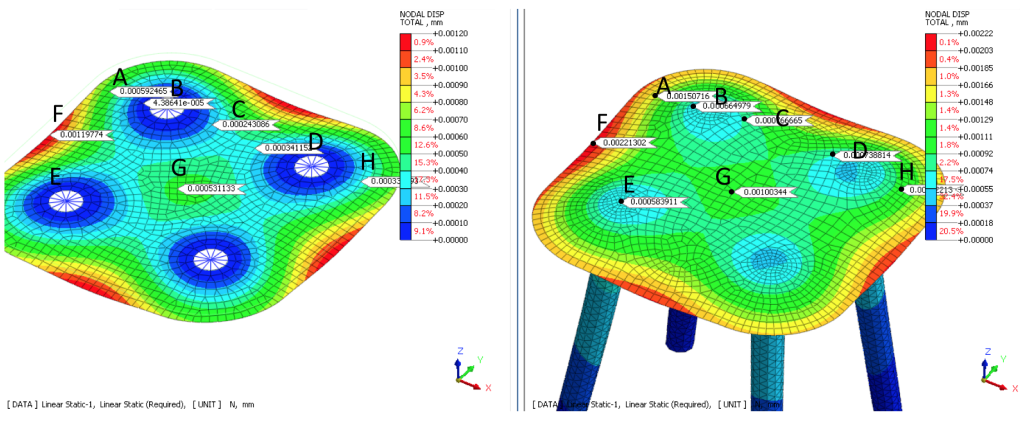Boundary conditions are probably where most of the engineers get it wrong.
Boundary conditions have a great impact on the result of analysis and a simple mistake in BCs makes the difference between a model with 30% of error and 3% of error.
Here’s a simple example in which the maximum difference goes up to 1416% (at point B, (6.6e-4-4.4e-5)/6.6e-4)

You may be thinking: “yeah, but the model looks different”…when in fact, it is the same model, but I just used different constraint schemes.
Boundary conditions are very simple to understand, contrary to what most FEA « experts » and consultants will tell you.
The Role of boundary conditions
I have been categorized as an FEA expert because of my teaching of FEA simulation through webinars for years (link to my webinars)
I have always been shocked to realize that even some of the most educated engineers were not able to define correctly boundary conditions. They merely constrain a model and hope that they will get correct results… and when the results are not correct, they either curse the software or the CAD model.
The few who know the importance of boundary conditions, merely test a few combinations and fail to understand the overall strategy to constrain correctly an FEA model.
A model correctly constrained can lead to highly accurate results, but you can’t do it if you don’t understand the role of boundary conditions in the simulation:
- To fix the value of a displacement or a load on a specific area of the model
- To impart or not stiffness to the model
- To replace parts of the assembly
- To stabilize the solver in nonlinear analysis
- To suppress or create singularities near your model’s boundary
The truth is that there are many things to understand about boundary conditions, but once you know them and you understand the strategy, it becomes very easy and you won’t ever be annoyed again to set up your boundary conditions.
I’ll talk more about my strategies to constrain models in the next post…
Or maybe I’ll do a webinar about that if there are enough people asking me for it.
The truth is that I’d like to write right here everything I know, but it would take a lot of time and efforts. I prefer to do something once in live to be more efficient and also to explain better.
If you are interested in watching a webinar about the strategies to constrain a model correctly, please leave a comment and I’ll know I have to prepare something for you.
–Cyprien
———————————-
Update: My FEA course about boundary conditions is now available. You can join it here:
Please elaborate it more in a webinar.
I am also interested in proper constraining the model. Webinar would be great.
The webinar would help me as being FEM rookie.
It is essencial to properly define the boundary conditions in order to get accurate FEA. Please, a webinar about this topic would be awsome.
Yes, please give us further explanation. Thanks.
Yep, a webinar will be more useful. please do arrange for it.
Yes please :)
Also yes please. In particular for anatomical models
Yes please.
Really interesting topic this is. I always used to wonder how to tweak the boundary conditions. There’s not much option though
I would really like a webinar!
I would like you to put up a webinar on “constraining a model”..
Please sir, I do, and I think many will be striving to
I’d appreciate if you prepare a webinar about this topic also i have some questions about differrences between contacts and joints ? Especially using of bonded contact and fixed joints.
Hello Sir,
Yes, it would be great if you could schedule a Webinar.
I had given a seminar presentation at the university and was asked a simple question about the boundary condition- and I realized that I had done the entire analysis wrong!
My query is how do I determine the boundary condition for pressure in case of using finite elements which have 4 degree of freedom-x,y,z,p. I can also share more details about it or simply send you the presentation.
Best Regards,
Looking forward. Perhaps also include the effects of using weak spring/ friction/ meshing to stabilize the nonlinear model. Thank you!
Yeah, it would be good. Thank you.
Please do the webinar. Thank you.
Yes indeed. Please do a webinar and if possible at earliest as most of us would love to have a better understanding.
Great sir! Please conduct a webinar on this .
Please make a webinar, it helps many.
please make a webinar
Yes sir. Needed webinar for boundary condition.
yes please